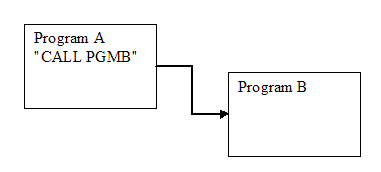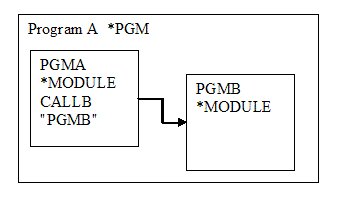One area of moving to RPG IV always seems to cause people confusion: migrating two individual programs from RPG III to RPG IV and then deciding whether to use a CALL or CALLB between them.
Take this scenario for example: Program A is a typical file maintenance (data entry) application. When the user presses F4 while in Program A, a second RPG program, Program B, is called. Program B is a customer lookup routine. When you decide to migrate these two programs to RPG IV, how will you connect them (that is, bind them together)?
Often, programmers feel the need to replace the CALL with a CALLB operation. Let's look at this specific situation.
This design is described as follows:
1. Two individual *PGM objects
2. Two source members--one for Program A and one for Program B
3. Dynamic call from Program A to Program B
To convert this type of application to RPG IV, you first run the CVTRPGSRC command over both source members. Then, you use one of the third-party tools that goes further and enhances the RPG III legacy opcodes by converting them into more contemporary RPG IV operations. One product that works well is the Linoma (www.linoma.com) package, but there are others.
Now, you have two RPG IV source members that need compiling, so what is the next step? You have two choices:
Option A: Create a bound application
- Change the CALL opcode in the source for Program A to a CALLB.
- Use PDM option 15 (the CRTRPGMOD command) and compile the source into *MODULE objects.
- Use the CRTPGM command to bind the two modules together into a single program object.
- Do not change the CALL opcode in the source for Program A to a CALLB.
- Use PDM option 14 (the CRTBNDRPG command) to compile the two source members into two separate *PGM objects.
Option A is the most popular choice, but which choice is the right one? The correct answer is, "It depends."
If you select option A, the program structure ends up as follows:
The advantage of this structure is that only one object is in production. Of course, three objects have to be managed: Module A, Module B, and Program A. But once Program A is put into production, you can delete the modules.
The ability of a module to call another module is an interesting component of ILE--one I am not a fan of. The reason for my opinion is that when one RPG IV module calls another RPG IV module, the RPG program cycle is evoked. The latest information I have indicates that the RPG cycle is about 12,500 lines of code. A dynamic call is about 2,500 lines of code. These figures may be out of date, but for comparison purposes, the ratio is probably still accurate.
By changing the original program from a CALL opcode to a bound CALLB opcodes, you reduce the number of lines of code required to call Program B from 2,500 to 250. This reduction might be even more substantial today since I'm using 1994 figures.
This means that the overhead for a CALLB operation is roughly 10 percent of the CALL overhead. This may sound good, but in this context is there any advantage?
When you realize that the RPG IV program cycle is actually evoked when even when a CALLB is used to call an RPG module, you see that the performance advantage of that CALLB is minimal. All you have to do is add up and compare the number of lines of code:
CALL: 12,500 lines + 2,500 lines = 15,000 lines
CALLB: 12,500 lines + 250 lines = 12,750 lines
15,000 – 12,750 = 2,250
By replacing the CALL opcode with the CALLB opcodes, the number of lines of code generated to jump from Program A to Program B is reduced by 2,250 lines, or approximately 15%. Hence, there does not seem to be a significant performance advantage in using CALLB instead of CALL in this context. In addition, you have to manage two modules and a program, instead of just the two programs.
The original version of ILE was shipped in OS/400 V2R3, and RPG IV was shipped in V3R1. Originally, RPG IV was shipped with a CALLB operation code but no support for procedures. This support came in V3R2 (CISC version) and V3R7 (PowerPC version).
I believe that, in order to promote the bound call interface, IBM began promoting the CALLB operation. Since there was no support for procedures in RPG IV at the time, IBM often advocated taking two programs, turning them into modules, and using the CALLB instead of CALL.
This one short-sighted recommendation has seemed to cause confusion in perpetuity. The recommendation should have been to use the CALLB to call bound procedures, such as the CEExxx APIs or any of the new bound APIs, and to use the CALLB (and eventually the CALLP) to call RPG IV subprocedures when they became available in V3R2.
An improved implementation of the RPG IV version of the two RPG III programs is as follows:
This implementation uses the same CALL opcode in the converted code as it does in the original, legacy RPG III applications.
Bob Cozzi has been programming in RPG since 1978. Since then, he has written many articles and several books, including The Modern RPG Language --the most widely used RPG reference manual in the world. Bob is also a very popular speaker at industry events such as COMMON and RPG World and is the author of his own Web site, rpgiv.com.


















 Business users want new applications now. Market and regulatory pressures require faster application updates and delivery into production. Your IBM i developers may be approaching retirement, and you see no sure way to fill their positions with experienced developers. In addition, you may be caught between maintaining your existing applications and the uncertainty of moving to something new.
Business users want new applications now. Market and regulatory pressures require faster application updates and delivery into production. Your IBM i developers may be approaching retirement, and you see no sure way to fill their positions with experienced developers. In addition, you may be caught between maintaining your existing applications and the uncertainty of moving to something new. IT managers hoping to find new IBM i talent are discovering that the pool of experienced RPG programmers and operators or administrators with intimate knowledge of the operating system and the applications that run on it is small. This begs the question: How will you manage the platform that supports such a big part of your business? This guide offers strategies and software suggestions to help you plan IT staffing and resources and smooth the transition after your AS/400 talent retires. Read on to learn:
IT managers hoping to find new IBM i talent are discovering that the pool of experienced RPG programmers and operators or administrators with intimate knowledge of the operating system and the applications that run on it is small. This begs the question: How will you manage the platform that supports such a big part of your business? This guide offers strategies and software suggestions to help you plan IT staffing and resources and smooth the transition after your AS/400 talent retires. Read on to learn:
LATEST COMMENTS
MC Press Online